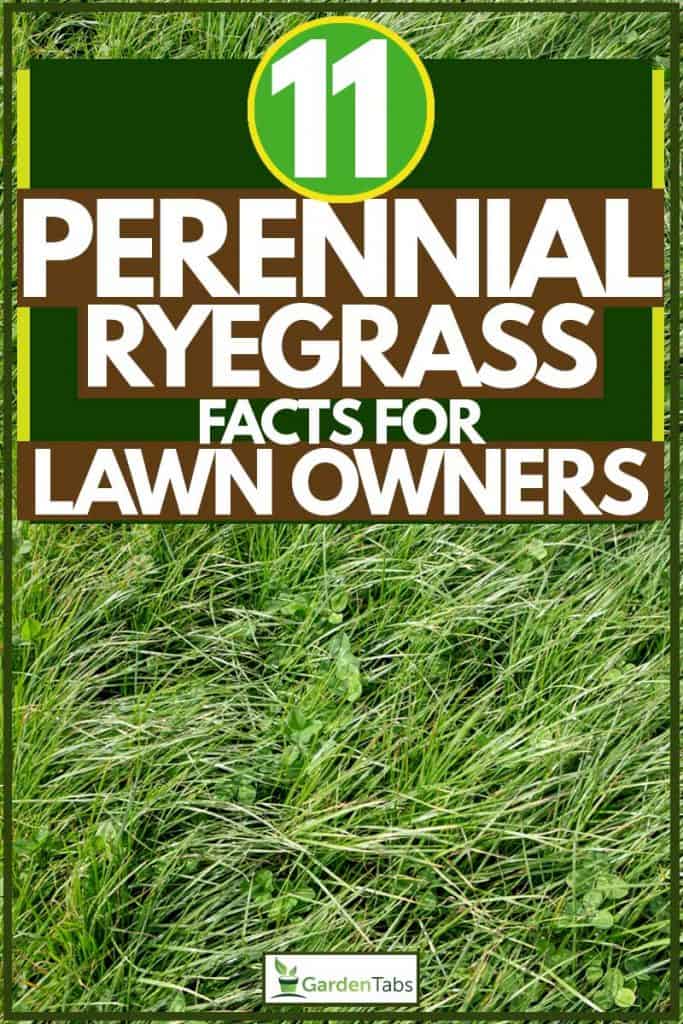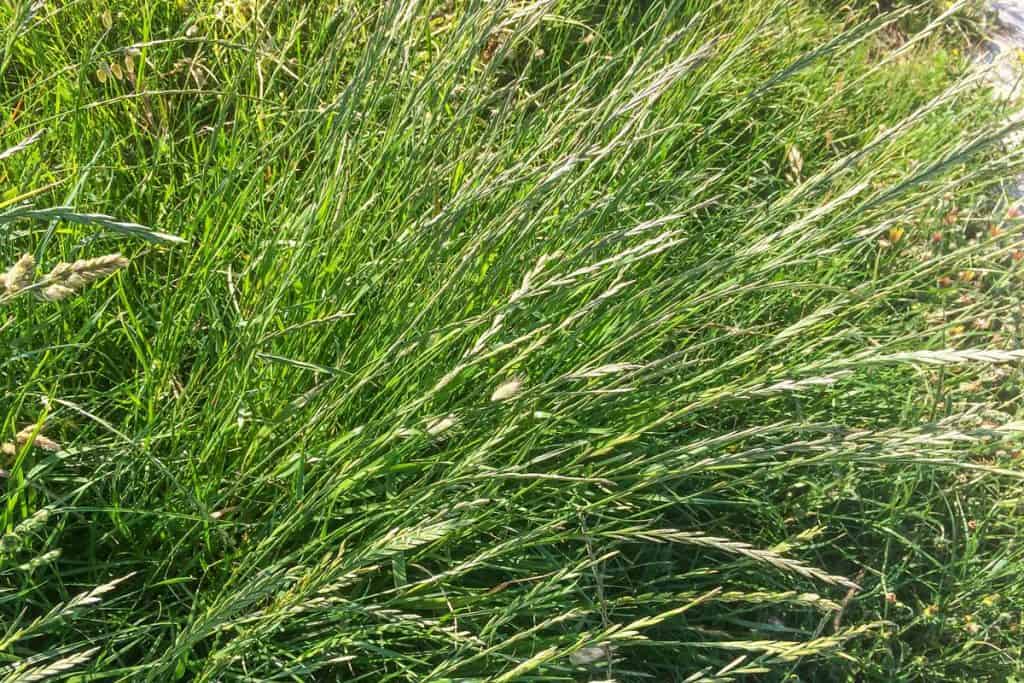 It's hard to know what the best grass is to plant and when. If you have a raw lawn due to new construction, patchy growth, or something like a septic tank dig, you might consider using perennial ryegrass. It's a great way to get a stand of grass growing quickly, especially if the weather is still cool outside. It won't be your best grass for deep hot summer, but some varieties may still work depending on your location.
It's hard to know what the best grass is to plant and when. If you have a raw lawn due to new construction, patchy growth, or something like a septic tank dig, you might consider using perennial ryegrass. It's a great way to get a stand of grass growing quickly, especially if the weather is still cool outside. It won't be your best grass for deep hot summer, but some varieties may still work depending on your location.
Here is a quick list of perennial ryegrass facts.
- Grows great in cool weather
- Germinates fast
- Works for temporary lawns
- Super for permanent lawns
- Can handle some shade
- Cold tolerant
- Drought and heat tolerance varies
- Can be used in pastures for grazing
- Lush and beautiful grass
- Tolerates low mowing
- Works well in conjunction with bermudagrass
We're going to look in-depth at these ryegrass tips as we continue with the post below. Hopefully, you'll find all the answers to your questions and maybe a few things you didn't know.
11 Tips On Perennial Ryegrass

If you've ever driven by a construction site in early spring or late fall and seen brilliant green new grass poking up through red clay soil, chances are that it's ryegrass. This quick-growing grass is popular because of its ability to grow in cool weather and come up fast. It's a way to keep run-off from happening on raw dirt lawns and areas.
We're going to look at what you need to know about ryegrass now.
Grows Great In Cool Weather
One reason perennial ryegrass is a staple of anyone shopping for grass seed is its ability to germinate in cool weather. This grass does best when soil temperatures are between 50 and 65 degrees Fahrenheit. Those soil temperatures usually indicate a daytime air temperature range of 60-75 degrees Fahrenheit. Summer plantings are riskier because the grass will go dormant at temperatures above 90 degrees. The same goes for winter temperatures below 50 degrees.
Germinates Fast
When you need grass to grow, you need grass to grow. Because perennial ryegrass has a fast germination rate, it's a great choice for getting grass quickly. Unlike fescue or bluegrass which can take up to ten days to germinate, ryegrass will start germinating in as little as five days. That's less than a week!
Works For Temporary Lawns
When you have a lawn area that has constant use and often needs reseeding, something like a sports lawn or heavily trafficked pasture area, ryegrass is a way to get grass growing back in quickly. Of course, you'll need to give it some time without traffic to have it germinate and establish.
Super For Permanent Lawns
If you live in areas of the country with cooler summers, ryegrass can be an excellent and beautiful choice as a permanent lawn grass. The recommended mowing height of an inch and a half to two and a half inches may be taller than most lawn caretakers are used to, but it will help perennial ryegrass withstand drought. If you have a particularly hot summer, the perennial ryegrass may need some extra TLC in the form of watering, overseeding, fertilizing.
Can Handle Some Shade
Though perennial ryegrass will not work in a super shady environment, as long as it receives a few hours of direct sunlight each sunny day it will grow. So you can have some partial shade and the ryegrass will do just fine. No need to cut down trees or anything crazy like that. Just look at your lawn and observe the sun's pattern. As long as all of your lawn gets sun for some of the days, you should be good to go with perennial ryegrass.
Cold Tolerant
Another reason to choose perennial ryegrass is that it can withstand the cold better than other grasses. For instance, tall fescue grass and other varieties of fescue will go dormant if the temperatures plummet much below fifty degrees Fahrenheit. Perennial ryegrass, on the other hand, will continue to grow even when the temperatures drop into the 40s. That means you'll have a few more weeks, maybe even a month, of grass than those who have lawns planted with less cold-resistant varieties.
Variable Drought and Heat Tolerance
Though not as good of a summer grass as the fescues, there are some variations of seed that require less water to survive than others. If you live in a hot/summer climate, you might want to mix your rye seed with fescue seed, though know that the mix needs to be right, or the fast-growing rye will choke out your other grasses. Be sure and read the bag of grass seed to see the recommendation for your area.
Can Be Used in Pastures For Grazing
Ryegrass is not only a good lawn grass, but it's also a good grass for pastures where animals graze. If you have an area that needs a quick boost of grass, you can take the animals off of it, plant some ryegrass seed, let germinate and grow for a month or two, then judiciously turn out your animals for an hour or so at a time. When planting ryegrass as a permanent grass in your pasture mix, be sure to keep it to no more than 20% of your mix so that it doesn't choke out the other varieties.
Lush And Beautiful Grass
When you think of golf course grass and turf do you think of lush green beauty? If your answer is yes, then you're thinking about ryegrass. Perennial ryegrass has a beautiful shine that reflects the light, giving it a show-stopping look in your lawn. It grows quickly in the spring and it stands out. Its color is a really rich medium bright green that invites you to sink your bare feet into.
Tolerates Low Mowing In The Cool Months
Though you should keep ryegrass at a slightly higher level to keep it rich and green, you can mow it lower if the weather remains cool. In the summer, though, mowing it too low will cause it to die off as it won't be able to retain enough moisture. If your lower will go as low as an inch and a quarter, this can help keep your ryegrass looking great.
Works Well In Conjunction With Bermuda Grass
If you have a bermudagrass lawn that you love but notice that it dies out too quickly in the fall, then perennial ryegrass may be its perfect partner. Ryegrass can be overseeded on a bermudagrass lawn to provide a rich green color until temperatures get down into the low 40s. This way you get a beautiful lawn for most of the months of the year, depending upon where you live.
We hope this post filled you in on all the perennial ryegrass facts and tips you ever wanted to know. Remember to always read the specifics on the bag of seed to see if it works for your particular situation, area, and temperatures. Seed companies continue to come out with new variations to withstand drought, heat, and shade situations.
If you enjoyed this post, then please read a few of our other posts that may be of interest to you. Check them out here -
9 Types of Sod Grass That May Be a Good Fit for Your Lawn
